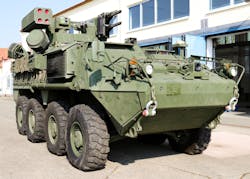Laser weapons have come closer to the battlefield since our last report. The U.S. Armed Services are already testing 50 kW-class solid-state lasers in full-scale military weapon systems.
The Army has already installed and successfully tested one in its M-SHORAD (Mobile Short-Range Air Defense) system (see Fig. 1), and it will receive three more 50 kW laser systems in the next 18 months. And the Air Force, Air Force Special Operations Command, and Navy all are integrating 50 kW systems into their own equipment for similar tests of laser weapon performance in real-world tactical situations.
Meanwhile, the High-Energy Laser Scaling Initiative (HELSI), managed by the Office of the Secretary of Defense, has researchers trying to scale four laser technologies to 300 kW-class power for future military weapon systems. Reaching that target within the next 12 months is “ambitious but achievable,” says Mark Neice, executive director of the Directed Energy Professional Society (Albuquerque, NM). Reaching that power range would stretch the range of tactical laser weapons to tens of kilometers, an important step up from the current 50 kW systems now in testing.
Looking forward 40 years
The Pentagon is looking further into the future. Two years ago, the Office of the U.S. Air Force Chief Scientist for Directed Energy began assessing the potential importance of directed-energy weapons in 2060, a century after the military spent its first million dollars on laser research. Titled Directed Energy Futures 2060, its report was released at the end of June 2021.1 Its assessment of weapons based on beams of electromagnetic energy, including lasers, radio-frequency devices, high-power microwaves, millimeter waves, and particle beams, was optimistic but realistic.
The executive summary opened by writing, “due to the convergence of trends in technology and the evolution of the battlefield, [directed-energy] military capabilities have reached or passed a tipping point in their criticality” for military operations by the U.S., its allies, and their potential rivals. They say prospects for 2060 do remain limited for effects at ‘vast ranges,’ similar to the thousands of kilometers that the Strategic Defense Initiative of the 1980s envisioned for space-based nuclear missile defenses. But they are more optimistic about shorter ranges.
The team focuses on two “militarily relevant use cases”—ground- or sea-based defense and operations above 30,000 feet, where the standoff range is up to hundreds of kilometers. Solid-state lasers on the ground or at sea have shot down short-range rockets, artillery, and drones with powers to tens of kilowatts—and more tests are planned with the 50 kW beams. A decade ago, the Airborne Laser (ABL) shot down guided missiles from the air, but its lethal range was said to be limited to 135 km, insufficient for stopping boost-phase missiles.2 The chemical oxygen-iodine (COIL) laser used in ABL has largely been written off as a weapon.
“I’m extremely skeptical that we can put a large laser on an aircraft and use it to shoot down an adversary missile, even from fairly close,” Mike Griffin, then undersecretary of defense for research and engineering, said in 2020.3
However, it is now possible to build 100 kW-class fiber or solid-state laser that can destroy targets at “tactically relevant” distances to a few kilometers. Live-fire testing and simulations have demonstrated that a suitably powerful beam can disable or destroy targets within several seconds depending on their resistance to laser energy, their distance from the laser, and how tightly the power is focused onto the target. Little has been said about the lethal ranges that are actually achieved on specific targets, but according to the report, laser weapons can cause “destructive and damaging effects at militarily relevant ranges” to “small and relatively soft targets.”
The rapid development of solid-state and fiber lasers over the past 40 years made the panel optimistic about the next 40. They expect military goals to benefit from progress by civilian industry, especially in reductions of the size, weight, and power (SWaP) of laser equipment “that would make airborne, space-based, and all-domain [directed-energy] missions more viable by 2060.” Increasing laser power to megawatt-class could reduce the duration of laser engagements at tactical range to less than a second. Optimistic estimates have laser powers reaching hundreds of megawatts by 2060.
Improvements in supporting technologies also could enhance laser propagation distance and accuracy from fast-moving platforms. Adaptive optics now can compensate for moderate levels of turbulence; even pessimistic estimates envision focusing megawatts of continuous power on targets. Better beam stabilization might improve pointing accuracy to hundreds of nanoradians.
300 kW by 2023
In 2018, Griffin told Congress that fiber lasers could be scaled to 300 kW to defend Air Force tankers from attack. Initially, power-scaling plans called for the Missile Defense Agency (MDA) to test a low-power laser demonstrator—an odd name for an effort to generate 300 kW. It was based on the successful demonstration of spectral beam combination in fiber lasers; essentially a very high-power version of wavelength-division multiplexing, which Lockheed Martin (Bothell, WA) had used to combine the output of 96 300 W fiber lasers into a 30 kW beam.4 High-level Pentagon discussions shifted plans to focus on demonstrating the feasibility of 300 kW output for tactical missions spanning tens of kilometers in what became the HELSI project, managed by the Office of the Secretary of Defense with the Army, Navy, and Air Force. Extending laser capabilities to strategic ranges of hundreds of kilometers will come later, Neice says.
HELSI has a broad remit of trying to scale four distinct laser technologies to the 300 kW range in parallel. Three of the technologies have already demonstrated powers in the 50–100 kW range: spectral beam combination in fiber lasers, coherent beam combination in fibers, and “distributed-gain” solid-state lasers developed by General Atomics (San Diego, CA). The fourth is diode-pumped alkali vapor lasers (DPALs), which may be able to reach even higher powers. Details are scarce on these projects because they fall under the Defense Counterintelligence and Security Agency’s new rules on “critical unclassified information.”5
Spectral beam combination was the first fiber laser technology to produce high beam quality at tens of kilowatts. Its early lead came from the fact that the fiber laser beams being combined are at different wavelengths in evenly spaced spectral slots, so the beams do not have to be in phase to blend into a single high-power beam without destructive interference. (In fact, the input beams can’t be coherent because their wavelengths differ.) Lockheed Martin and its Aculight subsidiary demonstrated a series of spectral beam combination lasers—first the 30 kW, then 60 kW, and reaching 100 kW in October 2019. That put Lockheed on track to scale to 300 kW.6 In November that year, they received a HELSI contract to build and demonstrate a standalone 300 kW laser.7
Coherent beam combination requires matching phases of multiple input beams at the same wavelength. The MIT Lincoln Laboratory (Lexington, MA) has been developing coherent beam combination for over a decade for diode lasers and waveguide amplifiers as well as for fiber lasers.8 In 2016, Lincoln demonstrated record brightness in what they called a “fiber combining laser,” for which they also achieved near-ideal power and high beam efficiency based on coherent beam combination. A key advance was extremely precise phasing of the light in the input fibers at their connection points, so constructive interference combined them to a single beam.
The required beam quality and power were demonstrated in 2019.9 Scaling of the technology then was transferred to Boeing (Huntington Beach, CA) under the HELSI program.10 nLight is also involved under a separate HELSI contract.
Distributed-gain lasers
The distributed-gain laser is a descendant of the High Energy Liquid Laser Area Defense System (HELLADS) developed over a dozen years ago by General Atomics. Details remain classified, but the original concept centered on flowing a liquid coolant with its refractive index matched to that of a solid-state laser material through channels in a laser made of that material. That index-matching would prevent refraction when light passed between the two materials, improving heat removal.
Light in the distributed-gain laser passes through a number of thin slabs with thin cross-sections, supposedly arranged in parallel but with the beam passing through them in series. Distributing the gain through multiple slabs and then combining the light they generate is said to reduce the complexity of both the cooling equipment and the optics, striking a balance that gives high performance and power from a compact system.11 Figure 2 shows an experimental system at General Atomics.In tests sponsored by the MDA, General Atomics demonstrated 100 kW output in October 2019. That pushed distributed-gain lasers across the threshold for scaling, and in April 2020, General Atomics received a HELSI contract for developing a prototype 300 kW class laser.12
Diode-pumped alkali lasers
Aside from being optically pumped by diode lasers, diode-pumped alkali lasers (DPALs) are quite different than the three other types being scaled up under HELSI. The diodes in DPALs pump alkali metal vapors on transitions that have exceptionally small quantum defects; a rubidium DPAL emits 98% of the energy it absorbs from a 780 nm pump photon, which is tremendously efficient by laser standards. However, overall efficiency is lower because it must account for losses in converting electrical input into the pump diode and into light for pumping the alkali vapor.
The MDA considers DPALs the most promising laser for boost-phase missile defense because it offers an attractive SWaP combination, near-infrared wavelength, and its potential to retain high beam quality when power is scaled.13 Advocates claim DPALs should be able to generate megawatt-class power, a level some think is beyond the reach of solid-state or fiber lasers.
Currently, however, DPALs are the least mature technology selected for scaling. Congress has approved money for MDA to support the Lawrence Livermore National Laboratory (Livermore, CA) to mature DPALs into a 60 kW class laser and develop a model of their operation to support future growth (see Fig. 3). Once that is achieved, the technology would be transitioned to industry for further scaling.14Field-testing 50 kW lasers
So far, Neice says, the Armed Forces have commissioned construction of seven 50 kW solid-state lasers for installation in weapon systems on military platforms. All are spectrally beam-combined fiber lasers to be installed by contractors or the services themselves in standard military equipment.
The Army has successfully tested one 50 kW laser built and integrated into a Stryker eight-wheeled armored combat vehicle (shown in Fig. 1) by Raytheon (Waltham, MA) and Dynetics (Huntsville, AL). The vehicle includes the M-SHORAD weapon system now entering deployment, which integrates existing sensors, guns, missiles, rockets, and now lasers to defend maneuvering troops against attack by drones and aircraft.15 The laser weapon is a follow-on to the Army’s HELMTT program. Northrop Grumman (Falls Church, VA) had been in the running to build the weapon lasers for Strykers, but problems in the power and cooling system left the company unable to meet Army contract criteria.16 Three more 50 kW laser systems will be delivered over the next 18 months. All four lasers will be put through their paces while installed in standard battlefield vehicles and weapon systems to test how effectively they perform under realistic combat conditions. The Navy now is integrating its first 50 kW laser from Lockheed with other combat equipment to give it full-up weapon capability. By year-end, it will be delivered to a San Diego shipyard for installation in a combat ship. Called HELIOS, for High Energy Laser with Integrated Optical dazzler and Surveillance, the weapon system includes surveillance equipment, a dazzler to deter attack, and a high-energy laser to zap attackers.17
The Air Force is working to integrate a 50 kW-class laser weapon into a flight pod for fighter jets to protect them from incoming missiles. Called SHiELD (Self-protect High Energy Laser Demonstrator), the project has been in the works at the Air Force Research Lab for several years. Lockheed is building the laser, with Northrop Grumman supplying beam control equipment and Boeing supplying the pod. In 2020, the Air Force pushed planned flight tests to 2023. The tests are intended to determine the maturity of the laser technology for use on fighters.18
The Air Force Special Operations Command is working on its own demonstration of a 50 kW-class laser in an AC 130J aircraft, an advanced version of the venerable C-130 gunship used for close air support. The laser equipment is being integrated at the Naval Surface Warfare Center (Dahlgren, VA), with ground testing to start this year and integration into the aircraft and further testing next year.19
Looking into the future
Some delays were inevitable. It’s logical for the Air Force to want to test a laser for their top guns, but squeezing a 50 kW laser into a pod on a fighter jet is a much more difficult task than putting one into a ground vehicle or on a battleship. What’s remarkable is how fast high-energy fiber lasers have matured to a point where so many of them are being tested in combat scenarios.
Those tests will show what range the 50 kW lasers can achieve and how well they can perform on the field. The allure of scaling weapon lasers to 300 kW is the hope of stretching their tactical range to tens of kilometers, which would make them more valuable defense systems. Even if they can’t reach the ideal range, the higher power should make them more potent over shorter ranges. Getting to 300 kW is a challenge and reaching that power in the laboratory is a long way from having one ready for deployment. Laser weapons are far from a sure bet, but the giggle factor of the “Star Wars” era is gone.
REFERENCES
For the full list of references, please see https://bit.ly/Hecht-Nov21-References.
About the Author
Jeff Hecht
Contributing Editor
Jeff Hecht is a regular contributing editor to Laser Focus World and has been covering the laser industry for 35 years. A prolific book author, Jeff's published works include “Understanding Fiber Optics,” “Understanding Lasers,” “The Laser Guidebook,” and “Beam Weapons: The Next Arms Race.” He also has written books on the histories of lasers and fiber optics, including “City of Light: The Story of Fiber Optics,” and “Beam: The Race to Make the Laser.” Find out more at jeffhecht.com.



